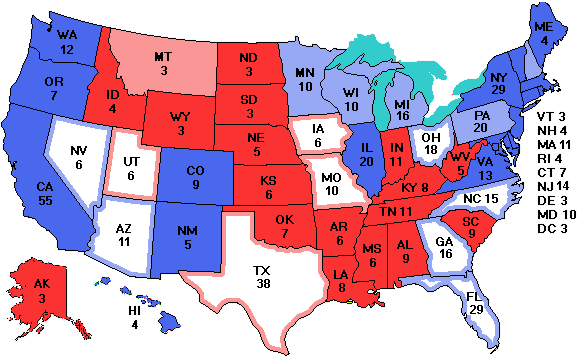• 1968 All Over?
• Esper Is in the Dog House
• Another Lousy Poll for Trump
• Zoom, Zoom, Zoom...
• "Send My Ballot to 1600 Pennsylvania Avenue"
• China and Iran Are Already Busy Hacking the Election
• COVID-19 Diaries, Friday Edition
• Today's Presidential Polls
• Today's Senate Polls
On Protests and Riots
Most Americans, if asked, would say they agree with the right of people to protest peacefully. And most Americans, if asked, would say they don't believe people have the right to riot. That means the line between the two is pretty important, not only legally but—in an election year, and with a president who will take any bugaboo he can get—politically. We've made this point before, but it's worth exploring a bit more fully.
Both journalists and historians know that there is no event, perhaps save a battle, that is harder to cover and make sense of than an urban uprising. Both sorts of events have no real focal point, the way that an important speech, court case, or treaty would. Every participant's experience is unique, and each is a significant part of the puzzle. Making things even more challenging is that two people can see the same exact thing and have radically different memories of it.
When it comes to the specific question of how many folks are protesters vs. how many are rioters, things get particularly challenging. First, it's not like an army of sociologists is out in the field right now, counting people and collecting data. Second, there are undoubtedly some folks who are both. And, perhaps most important, it's not so easy to figure out what it takes to move someone into the latter category. Using current events as an example, (Z) lives along an affluent portion of one of Los Angeles' major thoroughfares (Wilshire Blvd.). Note that this is not a testament to the fabulous salaries paid to the folks who teach at public universities; he just happened to get into the area when the market was way down. It was 1994, and the O.J. Simpson murders had taken place just six months earlier and two blocks away.
Anyhow, Wilshire has taken a beating in the last few days, such that there are more windows boarded up than not. And about half a mile west, there are three moderately high end restaurants within a few hundred feet of one another. One of those is untouched. A second was spray painted with all sorts of graffiti that read "Black Lives Matter" and "Justice for George." A third had its doors, windows, and waiting area smashed to bits, and some of its furniture was looted. At what point was the line crossed? The spray painting? After all, that is damaging property. The smashing of windows and doors? Now it's destruction of property. The taking of furniture? That adds theft to the list. Or does the violence have to be greater than this, or perhaps directed at human targets, before we cross the line into rioting? These are hard questions to answer.
In any event, that means there is going to be a lot of room for framing these incidents, presenting them as something that is mostly acceptable, and even admirable, to the majority of Americans, or presenting them as something that is detestable and offensive to the majority of Americans. And to capture the range of possibilities, we are now going to deploy a few Venn diagrams. To start, it is at least possible that the relationship between the population of peaceful protesters with real grievances, and that of rioters who are crossing the line, looks something like this:
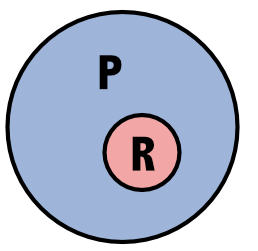
Joe Biden will argue that the relationship looks something like this:
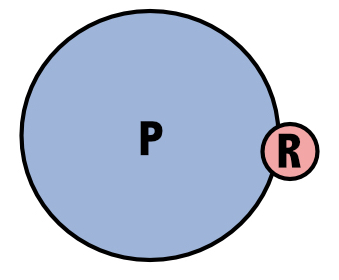
And Donald Trump will argue the relationship looks something like this:
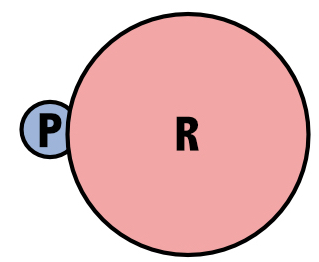
The election might just come down to whoever does the better job of selling people beyond their base on their chosen framing.
At the moment, Trump seems to be losing this particular battle. First, he's got the harder narrative to sell, as his framing of events appears to be pretty far divorced from reality. Beyond that, however, the President is grossly overplaying his hand, particularly with his threats to invoke the Insurrection Act of 1807, and to send American troops against American citizens. Trump's own Secretary of Defense, Mark Esper, has publicly objected to that, while the previous Secretary, Jim Mattis, lambasted the President in an op-ed on Wednesday. Now we have a set of three, as Clinton-era defense secretary William Perry released a scathing statement criticizing what he described as "a reprehensible political act."
These folks may actually be having a little bit of an effect; Sen. Lisa Murkowski (R-AK), she who voted for acquittal in the Ukrainepot Dome case, referenced Mattis' op-ed on Thursday and conceded that she is no longer certain she can support the President's reelection bid. She also implied that she has colleagues who are getting close to going apostate, remarking: "I felt like perhaps we are getting to a point where we can be more honest with the concerns that we might hold internally and have the courage of our own convictions to speak up."
With the Donald, it's always "in for a penny, in for a pound," so he certainly didn't let the blowback stop him or slow him down. He blasted Murkowski on Twitter, falsely insisted that he fired Mattis (as opposed to Mattis resigning), and re-tweeted a message from his former lawyer John Dowd that referred to the protesters as "terrorists using idle hate ... to burn and destroy." Perhaps the President can send a tweet today comparing the protesters to Nazis, and finish fulfilling the prediction made by Godwin's Law.
We don't have a crystal ball (just a gif of one), so we don't know if this kind of angry spin will impress any voters. What we do know, however, is that a major reason public sentiment swung in favor of the civil rights movement was because Southern governors—Orval Faubus of Arkansas, George Wallace of Alabama, Ross Barnett of Mississippi, etc.—grew far too extreme in their rhetoric, and far too violent in their actions. Trump certainly appears to be making the same mistakes. (Z)
1968 All Over?
The parallels between 2020 and 1968 seem so salient that articles on that theme have become something of a cottage industry. We wrote one here and another one here. That first item also commented on Julian Zelizer's piece on the subject, while we had an item Tuesday discussing Rick Perlstein's op-ed on the matter, and one yesterday that commented on Joshua Zeitz' 2020 vs. 1968 piece.
Each of these items—five in total—reached the same basic conclusion (although for different reasons), namely that Donald Trump is going to have a hard time running the Nixon playbook successfully. On Thursday, there were two more articles on 1968 published; they reach they same conclusion. First, CNN's Gregory Krieg, Dan Merica and Ryan Nobles argue that Trump's incendiary rhetoric is ill-matched to the circumstances. A challenger can harp on chaos and disorder, but that's usually a loser for the fellow sitting in the big chair. Empathy and compassion are what is called for, and Trump won't (and really can't) do that.
Meanwhile, The Washington Post's Michael S. Rosenwald believes that the comparisons to 1968 are way overblown, for a number of reasons. First, that election was more chaotic, with major candidates (Lyndon Johnson, Eugene McCarthy, Robert F. Kennedy) dropping in and then out, for various reasons. Further, 1968 was much more violent, while 2020 is more peaceful. And finally, he thinks that COVID-19 created a shared national struggle, one that affected nearly everyone, and put many Americans in a mood to be more empathetic.
Trump is going to run a "law and order" campaign, of course, because it's pretty much all he's got now that he can't run on the economy anymore. But a lot of people who know their stuff are not impressed with the chances that it will work. (Z)
Esper Is in the Dog House
The first rule of the Trump White House is "There is no Trump White House." No, wait. That's the first rule of Fight Club. The first rule of the Trump White House is that you do not challenge the throne under any circumstances. Mark Esper broke that rule this week, and he's already feeling the consequences.
It remains a great irony that the man whose catchphrase is "You're fired" is actually quite uncomfortable firing people. In this case, the optics would be particularly bad, since the Secretary would be getting fired for opposing the use of military force against Americans. It would make the President look more than a little authoritarian, and would also make getting a replacement through the Senate very difficult. And at a time when some senators may be ready to exit the S.S. Trump, no less (see above).
And so, instead of firing Esper, Trump is trying to get Esper to fire himself, sort of like Mitt Romney hoping undocumented immigrants would self-deport. Already, the Secretary is being frozen out of big meetings and decisions, while White House insiders are making sure to talk loudly enough that the Secretary hears who they think should replace him.
Maybe Esper will get back into Trump's good graces, but we doubt it. And maybe after three months of the cold shoulder, he'll get the message and fall on his sword, as his predecessor Jim Mattis did. However, we doubt that, too. If Esper really believes he is helping to keep the President from unleashing violent force against civilians—and that is not an unreasonable belief—then he will surely grit his teeth and bear the dog house treatment. After all, the Pentagon isn't even in Washington. (Z)
Another Lousy Poll for Trump
Earlier this week, there was a Washington Post/ABC News poll that had Joe Biden up 10 points on Donald Trump nationwide. Monmouth's new poll has it even worse for Trump, albeit by just a smidgen. They think Biden is up by 11 points right now, with 52% favoring the former vice-president, 41% favoring the current president, and 7% who somehow just haven't seen enough to be able to make a decision.
It should be noted that these two polls are outliers at the moment, and are at the very top of the pro-Biden range. That said, here are the last 30 national polls of the race, dating back to mid-April:
| Pollster | Poll span | Biden | Trump | Net |
| IBD/TIPP | 5/31 - 6/3 | 45% | 42% | Biden +3 |
| Emerson | 6/2 - 6/3 | 53% | 47% | Biden +6 |
| Monmouth | 5/28 - 6/1 | 52% | 41% | Biden +11 |
| CNBC | 5/29 - 5/31 | 48% | 41% | Biden +7 |
| Economist/YouGov | 5/31 - 6/2 | 47% | 40% | Biden +7 |
| CBS News/YouGov | 5/29 - 6/1 | 47% | 43% | Biden +4 |
| ABC News/Wash Post | 5/25 - 5/28 | 53% | 43% | Biden +10 |
| Economist/YouGov | 5/23 - 5/26 | 45% | 42% | Biden +3 |
| FOX News | 5/17 - 5/20 | 48% | 40% | Biden +8 |
| Rasmussen Reports | 5/18 - 5/19 | 48% | 43% | Biden +5 |
| Economist/YouGov | 5/17 - 5/19 | 47% | 42% | Biden +5 |
| CNBC | 5/15 - 5/17 | 48% | 45% | Biden +3 |
| Quinnipiac | 5/14 - 5/18 | 50% | 39% | Biden +11 |
| The Hill/HarrisX | 5/13 - 5/14 | 42% | 41% | Biden +1 |
| Harvard-Harris | 5/13 - 5/14 | 53% | 47% | Biden +6 |
| Economist/YouGov | 5/10 - 5/12 | 47% | 43% | Biden +4 |
| CNN | 5/7 - 5/10 | 51% | 46% | Biden +5 |
| Economist/YouGov | 5/3 - 5/5 | 46% | 42% | Biden +4 |
| CNBC | 5/1 - 5/3 | 47% | 44% | Biden +3 |
| Monmouth | 4/30 - 5/4 | 50% | 41% | Biden +9 |
| CBS News/YouGov | 4/28 - 5/1 | 49% | 43% | Biden +6 |
| IBD/TIPP | 4/26 - 4/29 | 43% | 43% | Tie |
| Emerson | 4/26 - 4/28 | 48% | 42% | Biden +6 |
| Economist/YouGov | 4/26 - 4/28 | 47% | 41% | Biden +6 |
| USA Today/Suffolk | 4/21 - 4/25 | 50% | 40% | Biden +10 |
| Economist/YouGov | 4/19 - 4/21 | 48% | 42% | Biden +6 |
| The Hill/HarrisX | 4/19 - 4/20 | 42% | 40% | Biden +2 |
| NBC News/Wall St. Journal | 4/13 - 4/15 | 49% | 42% | Biden +7 |
| Harvard-Harris | 4/14 - 4/16 | 53% | 47% | Biden +6 |
| Economist/YouGov | 4/12 - 4/14 | 48% | 43% | Biden +5 |
Perhaps you notice a bit of a theme running through the table. At least at the moment, Biden has the popular vote well in hand. Further, most pollsters' numbers are creeping slowly in his direction over time.
In 2016, Donald Trump lagged Hillary Clinton by 2% in the popular vote, and that was just barely enough for him to win. It's plausible that he might be able to push that to 3% or maybe 4% but no further. And it's looking like 3% or 4% is becoming his best-case scenario. (Z)
Zoom, Zoom, Zoom...
There is a long history of politicians gaining a big advantage by being the first to adapt to and exploit an emerging medium. Think Abraham Lincoln and telegrams, Franklin Delano Roosevelt and the radio, Dwight D. Eisenhower and television commercials, and Barack Obama/Donald Trump and social media. Well, the emerging medium du jour is Zoom, and some Democrats think they might be able to ride it to the promised land.
There are some red and/or purple states that are close enough this year that the blue team can practically taste them. The biggest prize among those is Texas, which is currently a tough hill to climb, but which also has a pile of electoral votes, not to mention a possibly competitive Senate race. Flipping the Lone Star state will depend upon large and successful voter registration drives, a very difficult task right now. First, because Texas law requires citizens to be trained and deputized before they can participate in voter registration activities. Second, because of COVID-19. The pandemic complicates both the training/deputization process, as well as the registering process.
That is where Zoom comes in. This weekend, Texas Democrats will hold their state convention virtually. And during that, Bruce Elfant (D), who manages elections in Travis County, will train and deputize 2,000 new registrars. Then, those folks will hit the ground when and where they can, and will hit the phones and Zoom when they can't. Who knows if it will be effective, but you don't know if you don't try. (Z)
"Send My Ballot to 1600 Pennsylvania Avenue"
Donald Trump publicly hates vote-by-mail, because he says that it facilitates fraud. Privately, he likes it very much, since that is how he has voted in every election since he reached the White House. And it turns out that, as he struggled to figure out where he really lives, he tried to register to vote absentee in Florida as a resident of Washington, D.C. That's against state law, so he eventually registered at Mar-a-Lago.
Needless to say, Trump has no problems with hypocrisy. However, he and his campaign are trying to win a PR battle about the legitimacy of voting by mail. It does not help his case when there are front-page headlines about the arrangements he personally makes to vote by mail. It also does not help his case when he labels registration errors as fraud, and then turns around and screws up his own registration.
Also on this front, Tennessee became the latest state to have a judge decree that vote-by-mail must be available to everyone this year. Davidson County Chancellor Ellen Hobbs Lyle found that any sort of limits, in the middle of a pandemic, constitute "an unreasonable burden on the fundamental right to vote guaranteed by the Tennessee Constitution." Her ruling will be appealed, of course. Still, the momentum for nationwide or near-nationwide vote-by-mail just keeps growing. (Z)
China and Iran Are Already Busy Hacking the Election
Yesterday, Google announced that Chinese and Iranian government hackers are already targeting the Gmail accounts of people working on campaigns. They are going after both Joe Biden's campaign and Donald Trump's campaign. It's nice to know they are nonpartisan in their hacking. They may be looking for material to disclose in an "October surprise" (or a "July surprise") or they may be looking for information that could help interfere with the election in some way. It is also possible they are looking for something to blackmail one of the candidates or the next president.
The Biden campaign responded to Google's announcement by saying: "We have known from the beginning of our campaign that we would be subject to such attacks and we are prepared for them." It is not clear what this actually means, if it means anything. If they were really serious about security, they wouldn't use Gmail at all, but a mail system that does end-to-end encryption all the time and automatically, like protonmail.com.
The Trump campaign responded to the announcement with "We are vigilant about cybersecurity and do not discuss any of our precautions." Sounds good, but those precautions may or may not be of any use. It is a fact of life that all security measures make using a computer more complicated and less convenient. Imagine that every time you wanted to read your email, you had to enter a password, type in an 8-digit code sent as a text message to your phone, and touch a fingerprint reader attached to one of your computer's USB ports. This would make it impossible for a hacker to break in by simply guessing your password, but some people would find this objectionable.
Google reported that the hackers used "phishing" this time. This consists of sending an e-mail that seems plausible and appears to come from a legitimate source. The content might say: "Meeting today: click here for the details." If you clicked on our link in the previous sentence, all you got was the Wikipedia page on "Phishing," but in the Chinese or Iranian e-mails, clicking on the link would install spyware or some other form of malware on the user's computer. This malware could search for valuable files and ship them off to Beijing or Tehran, install a "backdoor" to allow the hackers to log in remotely, or do something else to compromise the computer. A decent hacker would also have the compromised computer immediately send e-mails to everyone in the contact list with malware to compromise their computers as well, and so on. Gee, it's just like a virus spreading. In fact, it is a virus spreading, just a computer virus.
U.S. officials told Sen. Bernie Sanders (I-VT) earlier this year that he was the lucky recipient of help from Moscow, in an attempt to sow dissension among Democrats.
A new concern this year is the possibilities of weaponizing leaked e-mail. That didn't happen in 2016. The way that would work is to capture some campaign e-mail and modify it to make the effect worse. Imagine that the Russians penetrated Biden's email system and uploaded thousands of emails. Then in one e-mail, it added the sentence: "I think we should give every black person in the country $50,000 to make up for decades of past discrimination. We will pay for it by adding a $5,000 reparations tax to the tax bill of all white people." Sooner or later some reporter would discover this in the cache of thousands of e-mails that were released. Just imagine how Fox News would treat this "story." Biden would say: "That is completely false. I would never do that." Three days later SurveyUSA would release a poll showing that 46% of the voters believe it, 51% do not, and the rest haven't heard the story. Of course, weaponization could go the other way, too. Iran, for example, might decide it would prefer Biden and insert into a leaked Trump e-mail the sentences: "After the election, I am going to order massive nuclear strikes on Iran and North Korea. I'll teach them who runs the world." Most voters, even Republicans, don't want nuclear war, which is why Lyndon Johnson's "Daisy" ad was so effective. See more about it here. In short, the hacking season is upon us. (V)
COVID-19 Diaries, Friday Edition
Note: Due to some technical difficulties, this was rescheduled from its usual Wednesday slot.
Epidemiological statistical analysis is its own academic and professional specialty. It is very easy to form incorrect conclusions. Given that the amount of COVID-19 data generated is perhaps only exceeded by the amount of data generated by Major League Baseball, it is easy to find some tidbit that will confirm your bias, no matter what it is. You have to work very hard to avoid bias when looking for trends. For example, I am fully aware that the COVID-19 analysis of the United States is often divided into "the NYC metropolitan area" and "everywhere else." But when I compared the top 10 countries, I avoid the temptation to arrange the data in this way, and use my knowledge to "improve" the analysis. This is exactly how a data analysis can be corrupted.
The other issue encountered is that the statistics themselves will lie to you. Anyone who has studied regression analysis is aware that a small, randomly distributed sample with a single outlier can result in a "statistically significant" regression line. Here is a perfect example of this kind of problem. /rt.live (henceforth RT) provides a calculated R0 for each state. This is a very well done site that I highly recommend.
On June 3, the RT showed 10 states where the calculated R0 is > 1 (the line in the middle of the diagram):
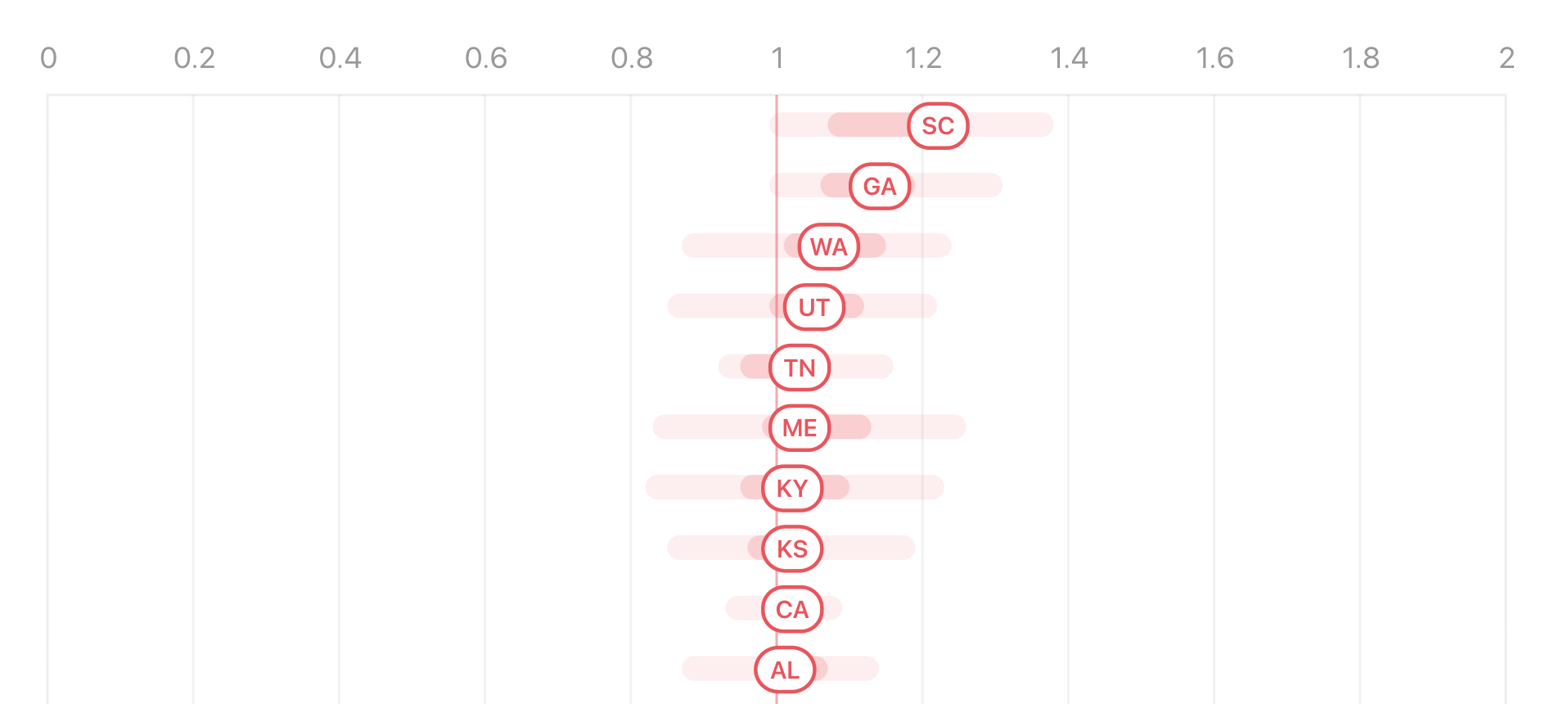
Every day, the states showing R0>1 change, as the calculation is so volatile. RT does show confidence intervals (the shaded areas) and the confidence intervals all crossed the 1.0 line (meaning that R0 might be 1.0), with the exception of Georgia (which just barely touched the line representing R0 = 1.0) and South Carolina (which was clearly above the line). Let us examine the daily new cases in Georgia:
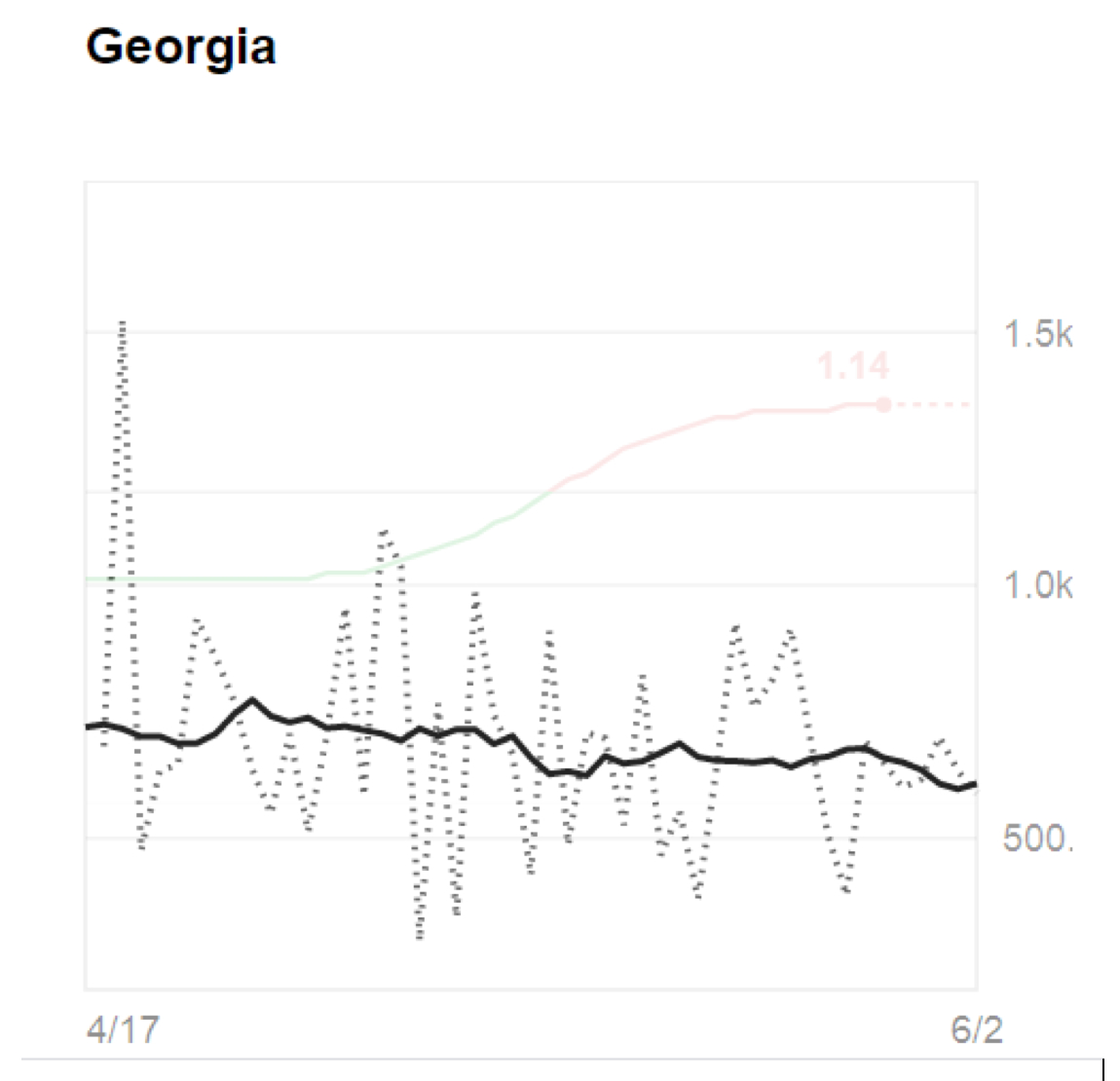
Even the long term trend line is going down. There is a lot of noise in the data, but no one would look at this and say: "wow things are clearly getting worse in Georgia." In fact, the best estimate for R0 is clearly less than 1.
The first time I saw this problem with RT was a few days ago with the R0 estimate for Texas. The site was showing the Texas R0 as being greater than 1 with the confidence interval not touching 1.0. The daily data for Texas did not confirm the calculation at all. The next day, RT recalculated the R0 values and ruined my perfectly good example. Every day they show a different set of states with R0 > 1. That itself should make us suspicious of the validity of the estimates.
How do these statistics provide a false picture of the actual situation? Confidence intervals (that give the probable range of the statistic) are calculated using assumptions of how the data is distributed. If those assumptions are not met, the confidence interval calculation will be incorrect. I think that is what happened here.
The RT folks are real experts. They are very careful and are in no way trying to deceive us. If I were to suggest an improvement, I would say to keep the R0 calculations as they are, but I would also test the data distribution assumptions that underlie calculations and use that analysis to modify the confidence interval calculations. This would make them wider (more conservative) and consistent with the gold standard "tummy test" (what your intuition tells you by looking at the actual data).
From a data presentation perspective, I also want to point out that it is easy to give more interpretive value to the R graph than it warrants. By laying out the states one above the other and ordering them, it looks like a nice smooth curve that we are more likely to believe.
Black people (but not all people of color) are being disproportionately affected by COVID-19. I have not yet addressed this topic here, as I was staying focused on tactical questions related to keeping us safe. However, the recent unrest spreading throughout the country has COVID-19 as part of the story and therefore is relevant here.
In the aggregate, black folks are dying at twice the rate as other ethnicities. In Michigan, the situation is much worse. Deaths in parts of the state are three times what one would expect based on the percentage of the population represented. This has been well addressed in many news stories and the various factors have been well discussed.
Ultimately, COVID-19 is waging a type of class warfare. The wealth gap in the U.S. divides us into those who can easily protect themselves from the ravages of COVID-19 and those who cannot. No tactic better exemplifies this than the 40% of people in the wealthiest neighborhoods of New York City who fled to safer areas. The ability to comply with almost every aspect of social distancing is class related. COVID-19's disproportionate effect on black people is a result of their position in our society.
In New Jersey, we are all on edge. Tempers flare more easily. Living with the stress caused by COVID-19 has made us all a bit crazy. All of my conversations with my neighbors include a discussion of who is sick and dying in our circle of friends and family. I try to imagine how I would feel living in a densely populated neighborhood, where COVID-19 is an unavoidable part of the environment. The current unrest is exacerbated by the presence of COVID-19.
The grotesque image of a policeman causing the death of a black man in custody is merely an illustrative example of the fundamental inequality (wealth, health, justice and otherwise) in America. It would be outrageous at any time, but the pandemic has brought emotions to a boil. This is the kind of powder-keg that revolutions are created from. It is crucial that we address the underlying issues thoroughly, calmly and constructively. (PD)
Today's Presidential Polls
Another poll of North Carolina, another reminder that state is very hard to predict. (Z)
| State | Biden | Trump | Start | End | Pollster |
| North Carolina | 49% | 45% | Jun 02 | Jun 03 | PPP |
Today's Senate Polls
This one's going to be a barn-burner. (Z)
| State | Democrat | D % | Republican | R % | Start | End | Pollster |
| North Carolina | Cal Cunningham | 43% | Thom Tillis* | 41% | Jun 02 | Jun 03 | PPP |
* Denotes incumbent
If you wish to contact us, please use one of these addresses. For the first two, please include your initials and city.
- questions@electoral-vote.com For questions about politics, civics, history, etc. to be answered on a Saturday
- comments@electoral-vote.com For "letters to the editor" for possible publication on a Sunday
- corrections@electoral-vote.com To tell us about typos or factual errors we should fix
- items@electoral-vote.com For general suggestions, ideas, etc.
Email a link to a friend or share:
---The Votemaster and Zenger
Jun04 ...and Jim Mattis Agrees
Jun04 The CIA Is Worried--about America
Jun04 Senate Republicans Are Against More $1,200 Checks
Jun04 Thirty Percent of the Voters Think the Country is Doing Well
Jun04 The NRSC Wakes Up
Jun04 Trump Is Betting the Farm on the Suburbs
Jun04 Is Trump Nixon or Johnson?
Jun04 Biden Plans to Attend George Floyd's Funeral
Jun04 Bush Administration Officials Form a Pro-Biden Super PAC
Jun04 Is the Fight for the House Already Over?
Jun04 New Mexico May Have a House Delegation Consisting Entirely of Women of Color
Jun04 Today's Presidential Polls
Jun04 Today's Senate Polls
Jun03 Checkmate
Jun03 Biden Gets Good Reviews...
Jun03 ...Trump, Not So Much
Jun03 Republican Convention in Charlotte Looks Doubtful
Jun03 Team Trump Works Hard to Stymie Vote-by-mail
Jun03 Today's Presidential Polls
Jun02 Trump Channels His Inner Tyrant...
Jun02 ...Which Is Playing Right into the Hands of Democrats...
Jun02 ...But Could Trump Have the Last Laugh?
Jun02 The G-7 May Be Falling Apart
Jun02 Pompeo Is Pompeout...
Jun02 ...and Steve King May Join Him
Jun02 Today's Presidential Polls
Jun02 Today's Senate Polls
Jun01 Biden Has a Double-Digit Lead over Trump Nationally
Jun01 Riots Become Political
Jun01 The Riots Change the Veep Calculus
Jun01 Maybe Warren Shouldn't Be on the Democratic Ticket
Jun01 Many Companies Are Speaking Out on Racial Justice
Jun01 Republican Plans for the Convention Have Come Out
Jun01 It's High Noon in Kansas
Jun01 Senate Rundown
May31 COVID-19 Diaries, Sunday Edition
May31 Sunday Mailbag
May30 Trump Had a Busy Day on Friday
May30 Saturday Q&A
May30 Today's Presidential Polls
May29 Trump Thumps His Chest
May29 Lies, Damned Lies, and Statistics
May29 This Certainly Isn't What the Founders Intended...
May29 ...Nor Is This
May29 The Veepstakes, Part I: Key Democratic Pollster Pushes for Warren
May29 The Veepstakes, Part II: Klobuchar Is in Trouble
May29 The Veepstakes, Part III: Cortez Masto Is Out
May29 RNC Working to Save Convention
May29 Today's Presidential Polls




